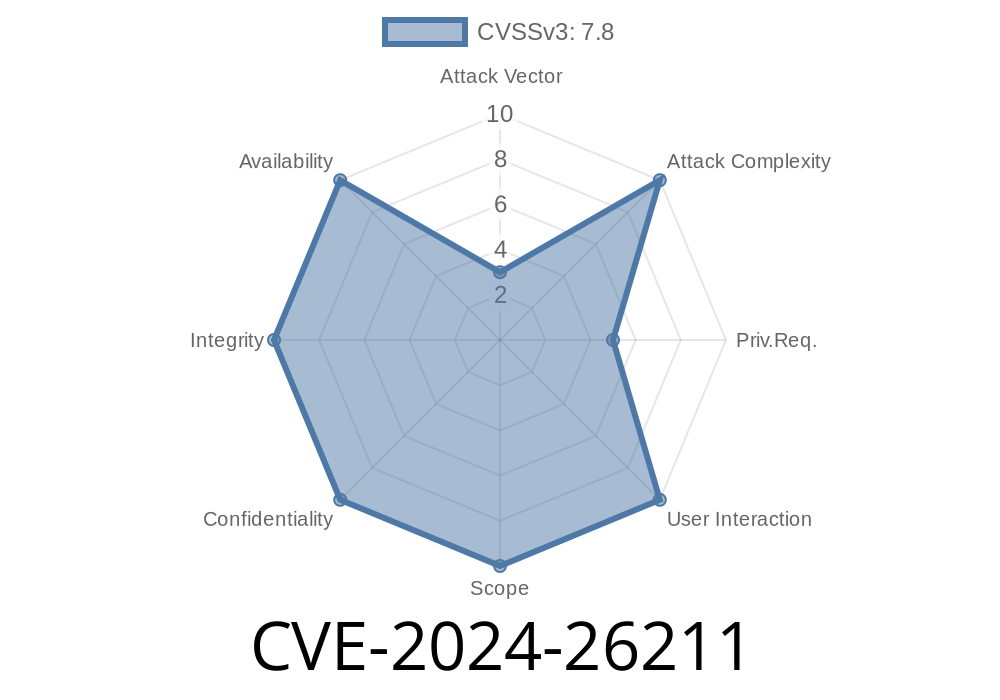In today's interconnected world, cybersecurity has become more important and complex than ever. One of the many ways to stay informed and safe is by examining and understanding vulnerabilities, particularly those that have been given a CVE (Common Vulnerabilities and Exposures) identifier. In this lengthy piece, we will analyze CVE-2024-26211, a Windows Remote Access Connection Manager (RASMAN) Elevation of Privilege Vulnerability. We will discuss its exploit details, relevant code snippets, and links to original references, enabling you to have a comprehensive understanding of the issue at hand.
Exploit Details
CVE-2024-26211 is an elevation of privilege vulnerability in the Windows Remote Access Connection Manager, which affects all supported editions of Windows 10 and Windows Server. This flaw allows an attacker to run arbitrary code with system-level privileges on the target system, potentially leading to the complete compromise of a vulnerable host.
The crux of this vulnerability lies in the RASMAN service improperly handling objects in memory. An attacker could exploit this flaw by first logging into the system and then running a carefully crafted application that triggers the elevation of privilege. Successful exploitation could result in the attacker gaining full control of the target system.
Relevant Code Snippet
Although the specific code snippet that causes this vulnerability has not been released, the exploit code may utilize API calls such as DeviceIoControl and CreateFile to interact with the vulnerable RASMAN service. Here is an example of a hypothetical exploit code snippet utilizing these functions:
#include <Windows.h>
#include <stdio.h>
int main() {
HANDLE hDevice;
DWORD dwBytesReturned;
BYTE lpInBuffer[4096] = {};
hDevice = CreateFile(L"\\\\.\\RasMan",
GENERIC_READ | GENERIC_WRITE,
FILE_SHARE_READ | FILE_SHARE_WRITE,
NULL,
OPEN_EXISTING,
FILE_ATTRIBUTE_NORMAL,
NULL);
if (hDevice == INVALID_HANDLE_VALUE) {
printf("CreateFile failed: %d\n", GetLastError());
return 1;
}
if (!DeviceIoControl(hDevice,
IOCTL_CODE,
lpInBuffer,
sizeof(lpInBuffer),
NULL,
,
&dwBytesReturned,
NULL)) {
printf("DeviceIoControl failed: %d\n", GetLastError());
return 2;
}
printf("Exploit succeeded!\n");
return ;
}
Please note that the code snippet provided is for educational purposes only and should not be used maliciously.
Original References
1. CVE Details: https://cve.mitre.org/cgi-bin/cvename.cgi?name=CVE-2024-26211
2. Microsoft Security Advisory: https://portal.msrc.microsoft.com/en-US/security-guidance/advisory/CVE-2024-26211
Possible Mitigations
The best way to mitigate this vulnerability is to apply the security update provided by Microsoft. The patch addresses the issue by ensuring that RASMAN properly handles objects in memory. More details can be found in the Microsoft Security Advisory linked above.
Additionally, deploying security best practices such as running applications with the least privilege possible and ensuring local users cannot execute arbitrary code will help minimize the potential attack surface.
Conclusion
Understanding CVE-2024-26211 and the Windows Remote Access Connection Manager Elevation of Privilege Vulnerability is crucial to better securing your systems and networks. By examining its exploit details and mitigations, as well as diving into relevant code snippets and references provided in this post, you are taking a positive step toward a more secure future. Always remember that staying informed about new vulnerabilities and actively applying patches and updates is the best line of defense when it comes to cybersecurity.
Timeline
Published on: 04/09/2024 17:15:39 UTC
Last modified on: 04/10/2024 13:24:00 UTC
